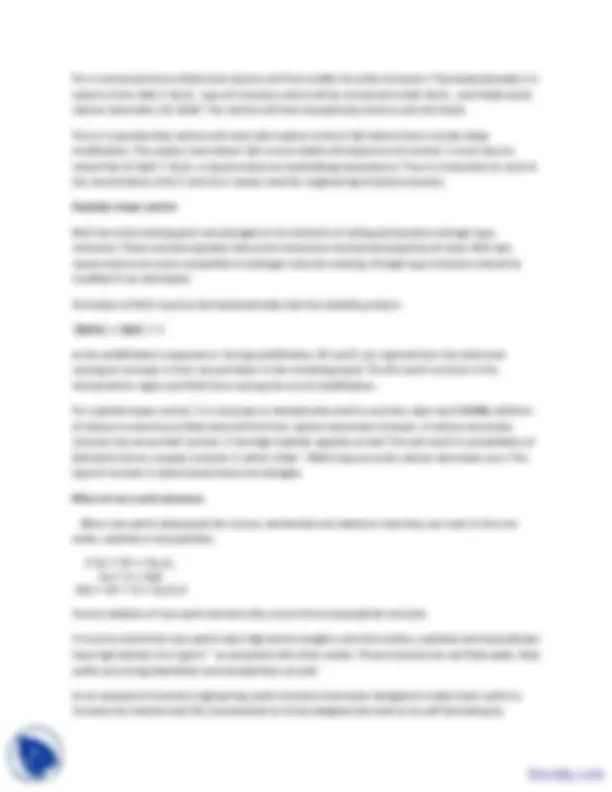




Study with the several resources on Docsity

Earn points by helping other students or get them with a premium plan


Prepare for your exams
Study with the several resources on Docsity

Earn points to download
Earn points by helping other students or get them with a premium plan
Community
Ask the community for help and clear up your study doubts
Discover the best universities in your country according to Docsity users
Free resources
Download our free guides on studying techniques, anxiety management strategies, and thesis advice from Docsity tutors
The major points which I found very informative are:Inclusion Engineering, Calcium Treatment, Oxide Shape Control, Sulphide Shape Control, Effect of Rare Earth Elements, Clean Steel, Steelmaking, Stringer Type, Continuous Casting Nozzle, Clogging of Nozzle
Typology: Study notes
1 / 4

This page cannot be seen from the preview
Don't miss anything!



Lecture 29 inclusion Engineering
Preamble
Requirements for inclusion engineering
Inclusion engineering by calcium treatment
Oxide shape control
Sulphide shape control
Effect of rare earth elements
Key words: Inclusion engineering, clean steel, steelmaking
Preamble
Inclusions engineering technology is based on the design of inclusions so as to alleviate their harmful
effects on the product properties.
Inclusion engineering does not refer to removal of inclusions but it refers to modify them either in terms
of chemical composition or shape so that harmful effects of the inclusions can be converted to improve
the steel properties.
Inclusion engineering also involves distribution of inclusion uniformly in the matrix. So that composite
properties can be generated in the product.
In some cases, deliberate attempts are made to form very fine inclusions (e.g. nitrides, and carbonitrides
inclusions in hardening steel). Such inclusion can form by reaction between Ti, W,Al with O, N, S or C.
Macro-size inclusions must be removed. In all other cases, depending on applications, inclusion can be
modified to minimize their harmful effects.
Requirements for inclusion engineering
One of the main requirements is to find an element which should be added to modify the inclusion.
Element should meet the following
What types of inclusions need to be modified?
Mainly Al
2
3
and MnS inclusions are modified. Al
2
3
inclusions are brittle and breaks on
deformation. Similarly MnS inclusion in steel on deformation becomes stringer type.
Inclusion engineering
In aluminum killed steels, alumina inclusions are formed. Alumina inclusions are solid at steelmaking
temperature. During continuous casting, alumina inclusions clog the nozzle and consequently steel flow
rate to the mold is affected. Calcium is used widely to modify inclusions in continuous casting of steel.
The solubility of calcium in steel is 320 ppm. The density of calcium is 1.
g
cm
3
� and is in vapour form
at steelmaking temperature
. Therefore suitable injection methods for calcium have to be
developed.
One method is to inject calcium deep into the molten bath such that the ferrostatic pressure overcomes
vapor pressure of calcium. In another method wire containing calcium components are injected at
speeds of 80-300 m/min. Typically Ca-Si powder in which calcium content is 20-30% is used in the wire.
Wire containing Ca-Si powder is injected deep into bath to avoid a) oxidation of Ca and b) to keep
calcium in the liquid form.
Addition of calcium in steel containing oxygen and sulphur can form two phases: oxide and sulphide.
Oxide phase consists of the compounds in CaO − Al
2
3
system. The different oxide compounds have
different melting temperature as shown in the table.
Compound Melting point (K) Ca/Al
3 CaO. Al 2
3
12 CaO.7 Al 2
3
CaO. Al 2
3
CaO. 2 Al
2
3
It may be noted that in 12 CaO. Al
2
3
has low melting point and it will remain in the liquid at
steelmaking temperature. The table also shows Ca/Al ratio in various CaO. Al
2
3
compounds. The
Ca/Al ratio is 1.27 in 12 CaO. 7 Al
2
3
compounds. This suggests that calcium/aluminum ratio has to be
adjusted at 1.27 (theoretically) in order to obtain liquid product.
The sulphide phase consists of CaS and MnS. The melting point of CaS is 2000 ℃ and that of MnS
1610 ℃. CaO. Al
2
3
melt has some solubility for CaS.
Oxide shape control
It consists of modifying Al
2
3
inclusions. Al
2
3
is solid at steelmaking temperature and is brittle in
nature. On rolling, alumina inclusions break up which is a serious surface defect. The alumina may
accumulate in the continuous casting nozzle causing clogging of the nozzle.
modifying the rheology of oxide inclusions. Glassy inclusions are designed to soften at the tool/chip
interface temperature so that a viscous layer of glass can lubricate the tool-chip interface. The
interested reader may go through the references.